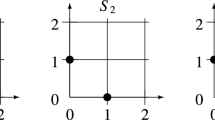Abstract
Convex envelopes are a very useful tool in global optimization. However finding the exact convex envelope of a function is a difficult task in general. This task becomes considerably simpler in the case where the domain is a polyhedron and the convex envelope is vertex polyhedral, i.e., has a polyhedral epigraph whose vertices correspond to the vertices of the domain. A further simplification is possible when the convex envelope is sum decomposable, i.e., the convex envelope of a sum of functions coincides with the sum of the convex envelopes of the summands. In this paper we provide characterizations and sufficient conditions for the existence of a vertex polyhedral convex envelope. Our results extend and unify several results previously obtained for special cases of this problem. We then characterize sum decomposability of vertex polyhedral convex envelopes, and we show, among else, that the vertex polyhedral convex envelope of a sum of functions coincides with the sum of the vertex polyhedral convex envelopes of the summands if and only if the latter sum is vertex polyhedral.
Similar content being viewed by others
References
Adjiman C.S., Dallwig S., Floudas C.A., Neumaier A. (1998). A global optimization method, αBB, for general twice-differentiable NLPs I. Theor. Adv. Comput. Chem. Eng. 22: 1137–1158
Androulakis I.P., Maranas C.D., Floudas C.A. (1995). αBB: A global optimization method for general constrained nonconvex problems. J. Glob. Optim. 7: 337–363
Al-Khayyal F.A., Falk J.E. (1983). Jointly constrained biconvex programming. Math. Oper. Res. 8: 273–286
Benson H.P. (2002). Using concave envelopes to globally solve the nonlinear sum of ratios problem. J. Glob. Optim. 22: 343–364
Benson H.P. (2004). Concave envelopes of monomial functions over rectangles. J. Naval Res. Logist. 51: 467–476
Benson H.P. (2004). On the construction of convex and concave envelope formulas for bilinear and fractional functions on quadrilaterals. Comput. Optim. Appl. 27: 5–22
Benson H.P., Erenguc S.S. (1998). Using convex envelopes to solve the interactive fixed-charge linear programming problem. J. Optim. Theory Appl. 59: 223–246
Crama Y. (1993). Concave extensions for nonlinear 0-1 maximization problems. Math. Programming 61: 53–60
Falk J.E. (1969). Lagrange multipliers and nonconvex programs. SIAM J. Control 7: 534–545
Falk J.E. (1974). Sharper bounds on nonconvex programs. Oper. Res. 22: 410–413
Falk J.E., Hoffman K.R. (1976). A successive underestimation method for concave minimization problems. Math. Oper. Res. 1: 251–259
Falk J.E., Soland R.M. (1969). An algorithm for separable nonconvex programming problems. Manage. Sci. 15: 550–569
Horst R. (1984). On the convexification of nonlinear programming problems: an applications-oriented survey. Eur. J. Oper. Res. 15: 382–392
Horst R., Tuy H. (1993). Global Optimization: Deterministic Approaches, 2nd edn. Springer, Berlin
Giannessi, F, Tardella, F.: Connections between nonlinear programming and discrete optimization. In: Handbook of Combinatorial Optimization, vol. 1, pp. 149–188. Kluwer, Boston (1998)
Grotzinger S.J. (1985). Supports and convex envelopes. Math. Programming 31: 339–347
Kalantari B., Rosen J.B. (1987). An algorithm for global minimization of linearly constrained concave quadratic functions. Math. Oper. Res. 12: 544–561
Kleibohm K. (1967). Bemerkungen zum Problem der nichtkonvexen Programmierung. Unternehmensforschung 11: 49–60
McCormick G.P. (1976). Computability of global solutions to factorable nonconvex programs. I. Convex underestimating problems. Math. Programming 10: 147–175
Meyer C.A., Floudas C.A. (2003). Convex Hull of Trilinear Monomials with Positive or Negative Domains: Facets of the Convex and Concave Envelopes. In: Floudas, C.A., Pardalos, P.M. (eds) Frontiers In Global Optimization, pp 327–352. Kluwer, Boston
Meyer C.A., Floudas C.A. (2004). Convex Hull of Trilinear Monomials with Mixed Sign Domains. J. Glob. Optim. 29: 125–155
Meyer C.A., Floudas C.A. (2005). Convex envelopes for edge-concave functions. Math. Programming 103: 207–224
Rockafellar RT (1970). Convex Analysis, Princeton Mathematical Series, No. 28. Princeton University Press, Princeton
Rikun A.D. (1997). A convex envelope formula for multilinear functions. J. Glob. Optim. 10: 425–437
Ryoo H.S., Sahinidis N.V. (2001). Analysis of bounds for multilinear functions. J. Glob. Optim. 19: 403–424
Sherali H.D. (1997). Convex envelopes of multilinear functions over a unit hypercube and over special discrete sets. Acta Math. Vietnam 22: 245–270
Sherali H.D., Alameddine A. (1990). An explicit characterization of the convex envelope of a bivariate bilinear function over special polytopes. Ann. Oper. Res. 25: 197–209
Tardella F. (1988). On a class of functions attaining their maximum at the vertices of a polyhedron. Discrete Appl. Math. 22: 191–195
Tardella F. (1990). On the equivalence between some discrete and continuous optimization problems. Ann. Oper. Res. 25: 291–300
Tardella F. (2003). On the existence of polyhedral convex envelopes. In: Floudas, C.A., Pardalos, P.M. (eds) Frontiers In Global Optimization, pp 149–188. Kluwer, Boston
Tardella, F.: Constructing vertex polyhedral convex envelopes, forthcoming
Tawarmalani M., Sahinidis N.V. (2001). Semidefinite relaxations of fractional programs via novel convexification techniques. J. Glob. Optim. 20: 137–158
Tawarmalani M., Sahinidis N.V. (2002). Convex extensions and envelopes of lower semi-continuous functions. Math. Programming 93: 247–263
Tawarmalani, M., Sahinidis, N.V.: Convexification and global optimization in continuous and mixed-integer nonlinear programming. In: Theory, Algorithms, Software, and Applications, Nonconvex Optimization and its Applications, Vol. 65. Kluwer, Dordrecht (2002)
Author information
Authors and Affiliations
Corresponding author
Rights and permissions
About this article
Cite this article
Tardella, F. Existence and sum decomposition of vertex polyhedral convex envelopes. Optimization Letters 2, 363–375 (2008). https://doi.org/10.1007/s11590-007-0065-2
Received:
Accepted:
Published:
Issue Date:
DOI: https://doi.org/10.1007/s11590-007-0065-2




